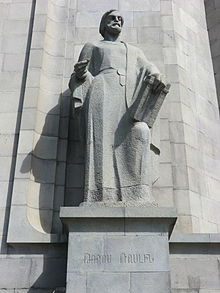Toros Roslin
| Toros Roslin | |
|---|---|

Statue of Toros Roslin in front of the entrance of Matenadaran
|
|
| Born | 1210 |
| Died | 1270 |
| Nationality | Armenian |
| Known for | Illuminated manuscripts |
| Patron(s) |
Catholicos Constantine I Hethum I |
Toros Roslin (Armenian: Թորոս Ռոսլին, Armenian pronunciation: [tʰɔɹɔs rɔslin]); circa 1210–1270) was the most prominent Armenian manuscript illuminator in the High Middle Ages. Roslin introduced a wider range of narrative in his iconography based on his knowledge of western European art while continuing the conventions established by his predecessors. Roslin enriched Armenian manuscript painting by introducing new artistic themes such as the Incredulity of Thomas and Passage of the Red Sea. In addition he revived the genre of royal portraits, the first Cilician royal portraits having been found in his manuscripts. His style is characterized by a delicacy of color, classical treatment of figures and their garments, an elegance of line, and an innovative iconography.
The human figures in his illustrations are rendered full of life, representing different emotional states. Roslin's illustrations often occupy the entire surface of the manuscript page and at times only parts of it, in other cases they are incorporated in the texts in harmony with the ensemble of the decoration.
Little is known about Toros Roslin’s life. He worked at the scriptorium of Hromkla in the Armenian Kingdom of Cilicia where the patriarchal see was transferred to in 1151. His patrons included Catholicos Constantine I, king Hethum I, his wife Isabella, their children and prince Levon, in particular. The colophons in Roslin’s manuscripts permit scholars to partially reconstruct the world in which he lived in. In these colophons Roslin appears as a chronicler, who preserved facts and events of his time. In his earliest surviving manuscript the Zeytun Gospel of 1256, Roslin signed his name as "Toros surnamed Roslin".
...
Wikipedia
